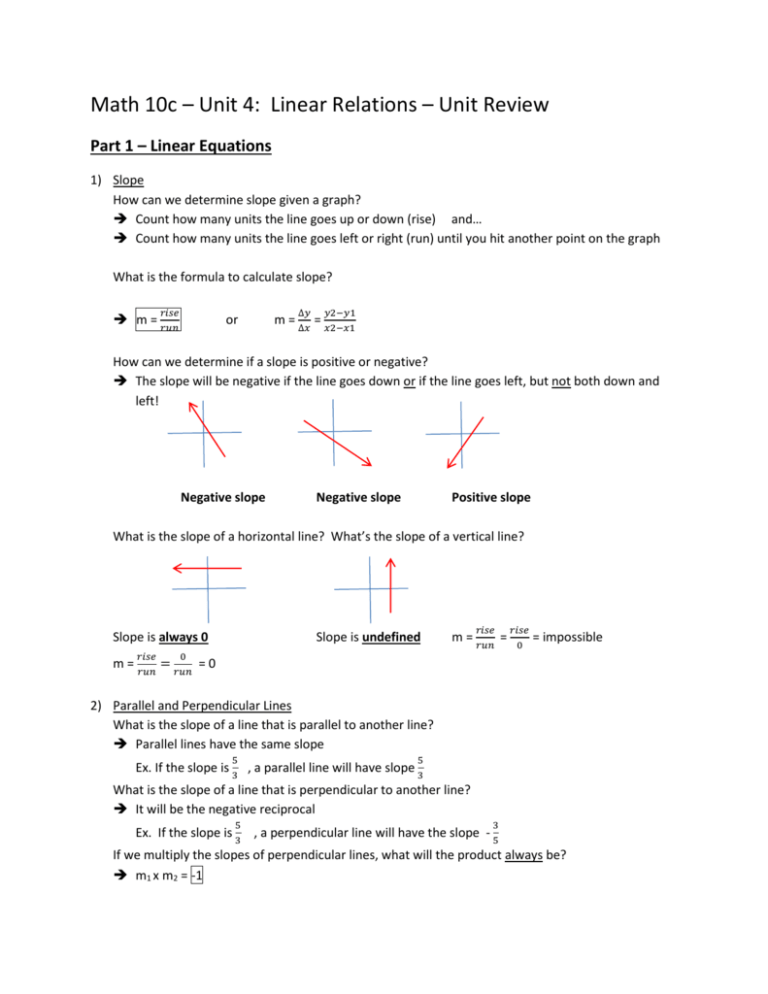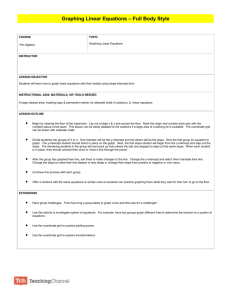Unit 4 Review Package - Linear Equations and Systems KEY
advertisement

Math 10c – Unit 4: Linear Relations – Unit Review Part 1 – Linear Equations 1) Slope How can we determine slope given a graph? Count how many units the line goes up or down (rise) and… Count how many units the line goes left or right (run) until you hit another point on the graph What is the formula to calculate slope? m= 𝑟𝑖𝑠𝑒 𝑟𝑢𝑛 or m= ∆𝑦 ∆𝑥 = 𝑦2−𝑦1 𝑥2−𝑥1 How can we determine if a slope is positive or negative? The slope will be negative if the line goes down or if the line goes left, but not both down and left! Negative slope Negative slope Positive slope What is the slope of a horizontal line? What’s the slope of a vertical line? Slope is always 0 𝑟𝑖𝑠𝑒 Slope is undefined 𝑟𝑖𝑠𝑒 m = 𝑟𝑢𝑛 = 𝑟𝑖𝑠𝑒 0 = impossible 0 m = 𝑟𝑢𝑛 = 𝑟𝑢𝑛 = 0 2) Parallel and Perpendicular Lines What is the slope of a line that is parallel to another line? Parallel lines have the same slope 5 5 Ex. If the slope is 3 , a parallel line will have slope 3 What is the slope of a line that is perpendicular to another line? It will be the negative reciprocal Ex. If the slope is 5 3 , a perpendicular line will have the slope - 3 5 If we multiply the slopes of perpendicular lines, what will the product always be? m1 x m2 = -1 3) Form 1: Slope y-intercept Form (y = mx + b) How can we determine the slope and/or y-intercept of a line given its equation? The slope y-intercept form tells us the slope and y-intercept! y = mx + b slope y-intercept How can we determine the slope and/or y-intercept of a line given its graph? Slope: Calculate rise over run by counting Y-intercept can be seen on graph Note: Can find exact values on graphing calculator! How can we graph an equation in slope y-intercept form? First, plot the y-intercept on the graph Second, using the slope, count the rise and run to plot other points on the graph Connect the dots 4) Form 2: Standard Form (a.k.a. General Form) Ax + By + C = 0 How can we convert standard form into y = mx + b? Ex. 10x – 4y + 7 = 0 10x + 7 = 4y 10 7 𝑥+ =y 4 4 5 7 y= x+ 2 4 How can we determine the x-intercept and y-intercept using general form? X-intercept = set y to 0 Y-intercept = set x to 0 Ex. -3x + 2y + 5 = 0 x-int y-int -3x + 2(0) + 5 = 0 -3(0) + 2y + 5 = 0 -3x + 5 = 0 2y + 5 = 0 -3x = -5 2y = -5 x = 5/3 y = -5/2 x-intercept = (5/3, 0) y-intercept = (0, -5/2) How can we graph an equation in general form? Option 1: Convert the equation into slope y-intercept form, then graph the y-intercept and slope Option 2: Determine the x-intercept and y-intercept, plot them on the graph and connect 5) Form 3: Slope Point Form y – y1 = m(x – x1) How can we determine slope given slope point form? The slope is given in the equation! (m) How can we convert slope point form into slope y-intercept form? Ex. y – 9 = -11(x + 3) y – 9 = -11x – 33 y = -11x – 24 How can we graph an equation in slope-point form? Plot the point that is given in the equation, then use the given slope to count rise and run. Ex. y + 3 = 2(x – 1) * The slope is 2 and the point is (1, -3) Part 2 – Systems of Linear Equations 1) Solving Systems of Linear Equations by GRAPHING How can we find the solution to a system of linear equations by graphing the lines? Simply, the point at which the 2 lines intersect is the solution 2) Number of Solutions to a System How can we determine the number of solutions to a system of linear equations? 1) LONG WAY: we can graph the system and compare both lines to see what the solution is 2) SHORT WAY: we can compare the 2 equations for the lines. It is easiest if we turn them into slope y-intercept form. Then we can see if they have the same slope and y-intercept! How many possibilities are there for # of solutions? The possibilities: 1) If the lines are parallel, there are NO solutions 2) If the lines are not parallel, there is 1 solution 3) If the lines are on top of each other (exact same slope and intercepts), there are infinite solutions 3) Solving Systems of Linear Equations by SUBSTITUTION What are the steps to solve a system of linear equations by substitution? 1) Choose the simpler equation to get one variable alone 2) Sub the expression from Step 1 into the other equation 3) Solve the single variable equation 4) Sub the solution from Step 3 into the original equation in Step 1 to solve the other variable Ex. x – 2y = -1 2x + 3y = 12 -- 1) Simpler equation x = 2y – 1 *Sub it into the other equation 2) 2(2y-1) + 3y = 12 3) 4y – 2 + 3y = 12 7y – 2 = 12 7y = 14 y = 2 *Now sub y into the original equation 4) x – 2(2) = -1 x – 4 = -1 x=3 4) Solving Systems of Linear Equations by ELIMINATION What are the steps to solve a system of linear equations by elimination? 1) If necessary, multiply each equation so that we can cancel out one of the variables 2) Add or subtract the two equations to eliminate one of the variables 3) Solve the resulting equation to get one of the variables 4) Substitute the solution into one of the original equations to get the other variable Ex. 4x + 2y -13 = 0 3x – 5y – 26 = 0 4x + 2y - 13 = 0 (x3) 3x – 5y – 26 = 0 (x4) 1) Multiply the top equation by 3 and the bottom one by 4 12x + 6y – 39 = 0 12x – 20y – 104 = 0 2) In this case, subtract, so the 12x will cancel out 12x + 6y – 39 = 0 - 12x – 20y – 104 = 0 26y + 65 = 0 3) Solve 26y = -65 y = -2.5 4) Sub y into the original 4x + 2y – 13 = 0 4x + 2(-2.5) – 13 = 0 4x – 5 – 13 = 0 4x = 18 x = 4.5 5) Applications of Systems of Linear Equations How can we solve word problems using systems of linear equations? Set up 2 equations, then use substitution or elimination to solve the variables. Answer in full sentences! Ex.






